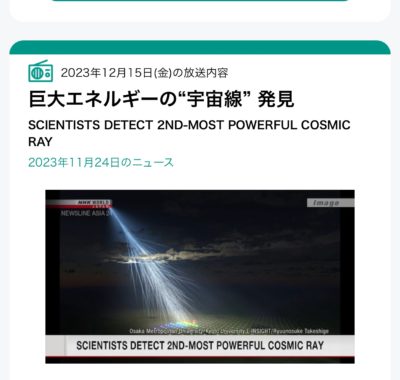ニュースで学ぶ現代英語 24/2/22,23/12/15(金)-関連記事-巨大エネルギーの“宇宙線” 発見
ブログ記事より抜粋
ニュースで学ぶ現代英語 23/12/15(金)-関連記事-巨大エネルギーの“宇宙線” 発見
Scientists detect 2nd-most powerful cosmic ray on record
Friday, Nov. 24, 7:17
科学者は記録上2番目に強力な宇宙線を検出
11月24日金曜日、7時17分
An international team of scientists says it has discovered the second most powerful cosmic ray ever recorded. Cosmic rays are high-energy subatomic particles that rain down on Earth from outer space. A calculation indicates that only 1 gram of the particle contains enough energy to destroy Earth.
国際科学者チームは、これまでに記録された中で2番目に強力な宇宙線を発見したと発表した。 宇宙線は、宇宙から地球に降り注ぐ高エネルギーの素粒子です。 計算によると、わずか 1 グラムの粒子に地球を破壊するのに十分なエネルギーが含まれていることがわかります。
The group of researchers from Japan, the United States and six other countries made the announcement this week. The group has regularly analyzed data from 507 cosmic ray detectors that started operating in the desert in the US state of Utah in 2008.
日本、米国、その他6か国の研究者グループが今週発表した。 同グループは、2008年に米国ユタ州の砂漠で運用を開始した507台の宇宙線検出器からのデータを定期的に分析してきた。
The group said it detected a cosmic ray with an estimated energy of 244 exa-electron volts in May 2021.
同グループは、2021年5月に推定エネルギー244エクサ電子ボルトの宇宙線を検出したと発表した。
The team named the particle “Amaterasu” after the sun goddess in Japanese mythology. Its energy intensity is second only to that of the “Oh-My-God” particle, which was measured at about 320 exa-electron volts in 1991.
研究チームはこの粒子を、日本の神話に登場する太陽の女神にちなんで「アマテラス」と名付けた。 そのエネルギー強度は、1991 年に約 320 エクサ電子ボルトで測定された「オーマイゴッド」粒子に次いで 2 番目です。
The team has sought to trace back the trajectory of the Amaterasu particle, but has so far failed to pinpoint its source. It said the particle could have been generated by the explosion of a massive star.
研究チームはアマテラス粒子の軌道を追跡しようとしているが、これまでのところその発生源を特定することはできていない。 この粒子は大質量星の爆発によって生成された可能性があるとしている。
One of the team members, Osaka Metropolitan University Associate Professor Fujii Toshihiro, said the group finally detected the particle after arduous observations. He added that the group will continue its observations to determine the particle’s source.
チームメンバーの一人である大阪首都大学准教授の藤井敏博氏は、チームは困難な観察の末に最終的に粒子を検出したと語った。 同氏は、同グループは粒子の発生源を特定するために観測を継続すると付け加えた。

